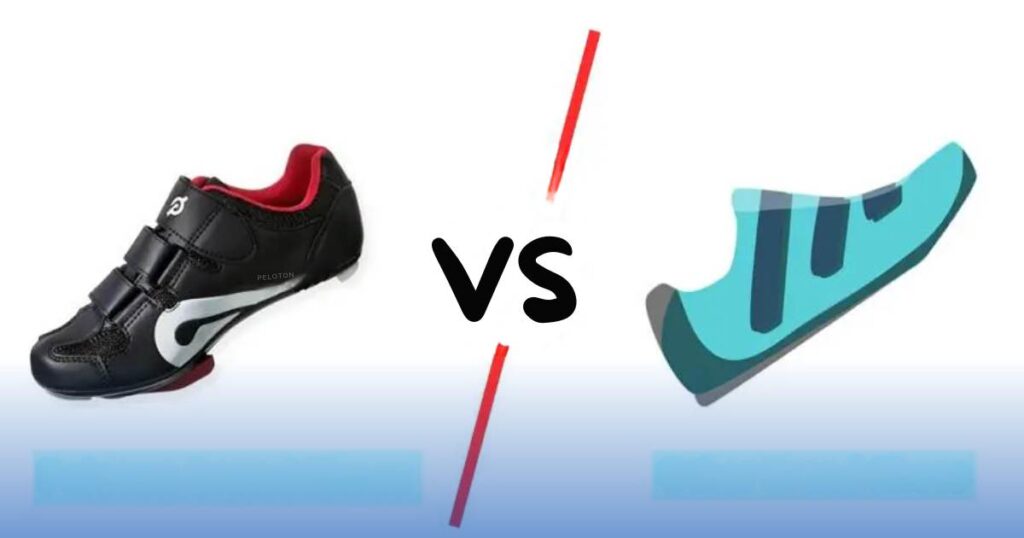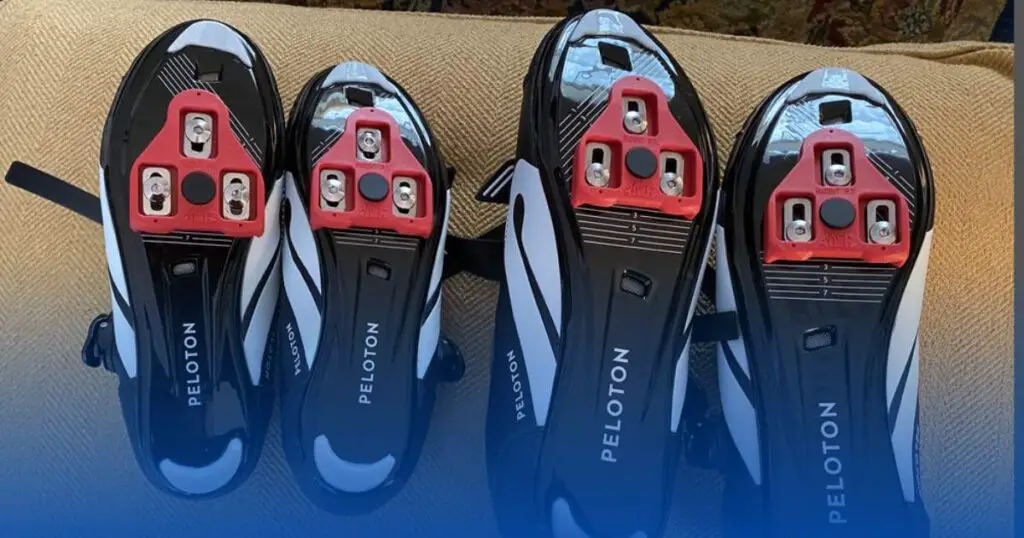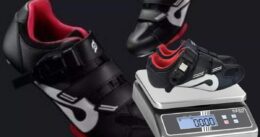if you’re a Peloton enthusiast, your attention to detail might have you contemplating even the seemingly inconspicuous elements of your workout arsenal—like the weight of your Peloton shoes.
Yes, those essential foot companions that effortlessly click into your bike, propelling you into a world of sweat, endorphins, and virtual instructors cheering you on. But here’s the kicker: have you ever paused mid-spin to ponder just how much these seemingly lightweight wonders truly weigh?+
Now, let’s talk about something often overlooked but crucial for your Peloton journey – the weight of Peloton shoes. Think of it like this: your Peloton shoes are the unsung heroes of your workout. They play a part in how comfortable you feel during those pedal strokes and impact the overall efficiency of your ride. Understanding the weight of Peloton shoes is like finding the right pair of sneakers for a run – it affects your performance and how enjoyable your workout is. In this post, we’ll dive into the nitty-gritty of Peloton shoe weight, unraveling its importance so that you can choose gear that suits your fitness style, keeping you comfortable and motivated in every ride. So, let’s roll (or pedal) into the details!
The Significance of Peloton Shoes Weight
Why Weight Matters to You
Alright, let’s dive into why the weight of your Peloton shoes is a big deal. Imagine it as the unsung hero of your cycling adventure. The weight is like the heartbeat of your shoes, influencing how smoothly you pedal through your Peloton workouts. These shoes aren’t your run-of-the-mill sneakers; they’re your trusty sidekick in the world of stationary cycling.
Impact on the Cycling Adventure
Now, let’s talk about how this weight thing affects your ride. A lighter shoe is like a secret turbo boost, making your pedal strokes feel lighter and helping you power through longer rides without feeling like your legs are turning into spaghetti. It’s like having a breeze at your back, encouraging you to go that extra mile. But, and this is a big but, it’s not just about going light for the sake of it. Some folks might prefer a bit more heft for stability, especially if they mix in floor exercises with their cycling routine. It’s all about finding your Goldilocks zone—neither too light nor too heavy, just right for your Peloton adventure.
Misconceptions and Peace of Mind
Let’s clear up a few things that might be buzzing around your head. First off, lighter isn’t always better. Sure, it might make you feel like a cycling superhero, but comfort, fit, and durability are heroes too. You don’t want shoes that feel like they’re from the featherweight boxing championship if they’re going to fall apart after a few rounds, right? And hey, if you’re worried about your joints, you’re not alone. Peloton shoes are designed to be the supportive buddies your joints need, balancing weight with comfort. So, don’t stress—your Peloton journey is about joy, not joint pain.
Understanding why your Peloton shoes have a weighty say in your workouts helps you pick the pair that fits your style. Whether you’re chasing speed records or savoring the journey, your shoes are there to make it a ride to remember. So, let’s pedal into your Peloton adventure, light or not-so-light, with confidence and a smile!
Unlocking the Secrets of Peloton Shoes: What Makes Them Tick?

Diving into the Heart of Peloton Shoes
Hey there, fitness enthusiasts! Ever wondered why Peloton shoes feel just right on your feet during those intense cycling sessions? Let’s take a closer look at the magic happening within these kicks.
The Lightweight Wizardry of the Upper Part: Breathable Bliss
Okay, so the upper part of Peloton shoes is like the superhero cape, ensuring you stay comfortable and cool. They use these nifty materials, like mesh and synthetic fabrics, to keep things light and breezy. Imagine a cozy, breathable hug for your feet! Some shoes even rock genuine leather for that touch of luxury. It’s like finding the perfect balance between a feather-light feel and durability. So, you’re not just cycling; you’re doing it in style and comfort.
The Sole Story: Where Grip Meets Lightness
Now, let’s talk about the sole – the unsung hero of your Peloton journey. It’s made of these cool materials, usually rubber or some high-tech stuff, to give you a grip without feeling like you’re dragging around anchors on your feet. The sole is like the foundation of a sturdy house, distributing weight for stability while you conquer those virtual hills. And guess what? That stiffness you feel? It’s not just a sensation; it’s Peloton’s way of making your pedaling more efficient. Power to the pedals, quite literally!
Lacing Up: Finding the Sweet Spot
How your Peloton shoes hug your feet is another piece of the puzzle. The laces, straps, or those fancy BOA systems—they all play a role in the snug fit. It’s like Cinderella but with a cycling twist. And Peloton doesn’t stop there. They sprinkle in features like ventilation, so your feet stay fresh, and throw in some anti-microbial mojo to keep the stink at bay. Plus, reflective bits for added flair and safety. It’s the little things that make your ride not just a workout but a whole experience.
Why Does It Matter? The Bottom Line
So, why bother unraveling the mystery behind Peloton shoes? Because knowing what goes into these kicks helps you appreciate the science behind your comfort. Peloton isn’t just throwing in cool features; they’re carefully crafting shoes that balance weight, comfort, and performance. It’s like having a cycling buddy that gets you, supporting you every pedal of the way.
Next time you slip into those Peloton shoes, remember – it’s not just footwear; it’s a key player in your fitness journey. Keep rocking those rides!
Comparing Peloton Shoes to Other Brands

Navigating Choices in Cycling Shoes:
As you delve into the world of cycling shoes, it’s like choosing the right pair of sneakers but with a spin – literally. Peloton shoes, designed for the Peloton bike, share the stage with big players like Shimano, SIDI, and Specialized. Each brand has its flair, and the weight of the shoes is a factor that can tip the scales when deciding.
Peloton vs. Shimano:
Think of Peloton shoes as the specialists of the indoor cycling scene, while Shimano is the seasoned all-rounder. Peloton shoes prioritize comfort for your at-home cycling sessions, while Shimano offers a broader range that caters to both indoor and outdoor cycling adventures. If your pedals hit both the Peloton and the open road, weighing the balance between specialized comfort and versatile performance is key.
Peloton vs. SIDI and Specialized:
SIDI and Specialized are like the rockstars of outdoor cycling shoes. If you’re eyeing the great outdoors, their shoes might be calling your name. Peloton shoes, born for the indoor stage, may feel a bit different in terms of weight and features. The catch is in the details – breathability, sole stiffness, and compatibility with different pedal systems. These factors play a role if you’re considering using the same pair for your Peloton rides and weekend cycling escapades.
Why It Matters for You:
Choosing between Peloton shoes and other brands isn’t just a numbers game. It’s about finding the Cinderella fit for your cycling goals. If your heart (and pedals) belong to Peloton, their shoes are tailored for that stage. The weight isn’t just a number; it’s about feeling comfortable during your indoor cycling symphony. On the flip side, if you’re eyeing both indoor and outdoor scenes, the weight comparison dance becomes more intricate.
In the end, it’s your cycling story. Understanding how Peloton shoes stack up against the competition, not just in weight but in the entire performance ensemble, helps you pedal into a decision that aligns with your comfort, goals, and the adventures that await. Happy cycling!
User-Friendly Experiences with Peloton Shoe Weight
Finding the Right Balance for Comfort
Peloton users consistently rave about the comfort and satisfaction derived from the weight of Peloton shoes. These kicks seem to strike a sweet spot, offering stability during intense rides without feeling like you’re lugging around cement blocks on your feet. Users often describe the weight as providing a grounded and connected feeling, enhancing the overall Peloton experience. It’s like finding the Goldilocks zone – not too heavy to hamper movement, yet not too light to compromise the sense of durability and quality.
Adjustment Period and Initial Concerns
For some, especially those new to Peloton or transitioning from lighter shoes, there might be an adjustment period. Initial concerns about the weight being on the higher side are not uncommon. However, the consensus among seasoned users is to give it a few sessions – let your feet and the shoes get acquainted. It’s akin to breaking in a new pair of running shoes; the more you wear them, the more they mold to your comfort. Addressing this adjustment period in user reviews helps paint a realistic picture, ensuring potential buyers aren’t taken aback by the initial feel.
Performance Insights: Heft for a Purpose
Beyond just comfort considerations, many users highlight how the weight of Peloton shoes plays a role in actual riding performance. The slightly higher weight contributes positively to stability during those intense, heart-pounding rides. This means better power transfer and control, especially appreciated by riders who favor a more robust and secure feel on the bike. It’s like having a reliable pair of training wheels – you feel confident pushing your limits without worrying about balance. However, it’s crucial to recognize that preferences differ. Some users, especially those focused on speed and agility, might still lean towards lighter shoes.
Wrap-Up: Making an Informed Decision
Understanding how Peloton shoe weight intersects with both comfort and performance is key to making an informed decision. While user experiences generally praise the balance Peloton strikes, acknowledging the adjustment period and varied preferences provides a holistic view. Choosing Peloton shoes, it’s about finding your Goldilocks zone – a balance that aligns with your comfort and riding style. Whether you’re cruising or pushing your limits, these shoes aim to be the reliable companion that enhances, not hinders, your Peloton journey.
Tips for Choosing the Right Peloton Shoes

Finding Your Perfect Peloton Fit: A User-Friendly Guide
Selecting the right Peloton shoes is like finding the perfect workout buddy – it should match your style, make you feel good, and support your goals. Let’s break down the essentials without diving into complex jargon.
Comfort is Key: A Shoe That Feels Right
Imagine your favorite pair of sneakers – snug, supportive, and comfy. Your Peloton shoes should be no different. When trying them on, pay attention to how they feel. Check for any pinching or discomfort, and make sure there’s enough arch support. It’s like finding the Cinderella fit for your cycling adventures.
Fit for Your Fitness Goals: What Are You Aiming For?
Are you into heart-pounding sprints or prefer a steady, scenic ride? Your fitness goals shape the kind of Peloton shoes that will be your best match. High-intensity workouts might call for shoes with a secure fit and grip, while endurance riders might prioritize comfort and breathability. Think about what gets you excited to hop on the bike, and choose your shoes accordingly.
Match Your Moves: Tailoring Shoes to Your Riding Style
Your Peloton shoes should dance to the rhythm of your ride. If you’re all about quick bursts and sprints, look for shoes with a solid sole for that power transfer. On the flip side, if you enjoy longer rides, find a balance between comfort and performance. Think of it as finding the right shoes for your favorite dance – they need to keep up with your moves.
In a nutshell, picking the perfect Peloton shoes isn’t just about their weight; it’s about how well they vibe with you. Ensure they feel like an extension of your feet, align with your fitness aspirations, and groove with your riding style. By doing so, you’re not just strapping on shoes; you’re gearing up for a personalized Peloton journey that’s comfortable, enjoyable, and effective. So, find your fit, clip in, and let the cycling adventures begin!
Maintaining Your Peloton Shoes for Longevity and Top Performance
Caring for your Peloton shoes is like giving them a little love to ensure they go the extra mile with you. Imagine them as your trusty sidekick on your cycling adventures. To keep them in tip-top shape, it’s a good idea to regularly give them a once-over. Check the usual suspects – the closures, soles, and other high-stress areas. If anything seems off, don’t procrastinate; tightening screws and addressing wear promptly can save you headaches down the road.
Let’s talk about those closure systems – whether you’re dealing with laces, Velcro, or the high-tech BOA system. Keep them clean and functioning smoothly. A little love here goes a long way. Speaking of which, don’t forget the soles. A quick inspection can catch any issues that might hinder the power transfer from your foot to the pedal. It’s the small things that count, right?
Now, onto the not-so-glamorous but necessary part: cleaning. After a sweaty session, give your shoes a wipe-down with a damp cloth. It’s not just about looks; it’s about hygiene too. No one likes smelly shoes, and neither do you. If they’re particularly funky, consider using a spray to keep the odors at bay. Just a little maintenance ritual after each ride can add years to the life of your Peloton shoes.
When it comes to storage, think of your shoes like fine wine – they need the right conditions. Keep them in a cool, dry place, away from the harsh sun. To help them keep their shape, you can use shoe trees or stuff them with newspaper. And just like you, your shoes need to breathe, so don’t lock them away in a gym bag for too long. By following these simple steps, you’re not just taking care of your Peloton shoes; you’re ensuring a comfortable and hygienic cycling experience every time you hop on your bike.
Remember, it’s not just about practicality; it’s about making your cycling journey a smoother and more enjoyable ride. Your Peloton shoes have your back – or should we say, your feet – so treat them well, and they’ll keep you pedaling happily. Happy cycling!
Conclusion
1. Summing It Up:
So, there you have it – we’ve unpacked the whole deal about Peloton shoes and their weight. We started by pointing out why it’s crucial to know how much these shoes weigh and how it impacts your time on the bike. Breaking it down, we took a close look at what goes into making Peloton shoes and why the weight can vary between different models.
2. Choosing Your Perfect Fit:
Now, armed with this newfound knowledge, you’re in the driver’s seat to make smart choices based on what suits you best. We talked about the things that affect the weight of Peloton shoes, helping you figure out what matters most for your comfort and performance. Whether you’re deciding between Peloton models or comparing them to other brands, you’ve got the lowdown to make a decision that fits your style.
3. Real Talk from Real Riders:
But hey, we didn’t stop there. We brought in real stories from fellow riders to give you a peek into how Peloton shoe weight plays out in the real world. This isn’t just about numbers; it’s about how these shoes feel when you’re putting in the miles. Understanding the experiences of others gives you a feel for what to expect beyond the tech specs.
4. Your Ride, Your Rules:
Our goal is simple – to help you pick Peloton shoes that match your cycling groove perfectly. We tossed in some tips on figuring out what feels right for you, considering your comfort, fitness goals, and how you like to ride. It’s not just about the weight; it’s about finding the pair that makes your Peloton journey smoother and more enjoyable.
In a nutshell, this journey through Peloton shoe weight has been about giving you the lowdown in a way that makes sense. Now, armed with this info, go ahead and make choices that turn every pedal push into a joy ride. Your cycling experience is unique, and your shoes should be too!


